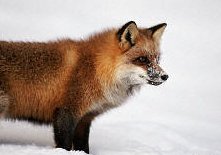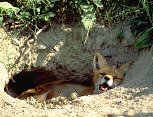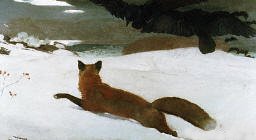Red Fox Unlike groundhog, possum and raccoon, red fox are hunted only during the winter months when they den below ground. The rest of the year, red fox spend almost all of their time above ground, resting in the shade of corn fields during the day, and prowling for food at night, at dusk, or in the early morning hours. In November, December and January, when most other animals are struggling to survive the winter, the normally solitary red fox begins to pair up. At this time the fox will begin to dig natal dens and start the courtship process prior to mating in January and February. Red fox almost always den within a few hundred yards of water, whether it is a stream or a pond, or merely a marshy area from which water can be lapped after a heavy rain. Like groundhogs, whose burrows they use for natal dens, red fox are careful to choose den sites with good drainage. If you are looking for a red fox den, walk into a cut-over corn field on a very cold day, preferably after a bad weather front has blown in. If you are lucky, you may come across an old groundhog den with the first three feet of the main entrance enlarged and typically dug into a tall oval shape to allow the red fox to bolt out at a full gallop. This excavated front end also serves as a kind of "porch" where the fox can rest out of the wind
Another sign you have found a fox den is that the dirt excavated from the hole will be kicked out backwards, without much regard to placement. While a fox digs dirt like a dog, a groundhog will pat it neatly into a mound. The most definitive evidence you have found a fox den, however, is if there has been any recent digging at all. Groundhogs are usually asleep at this time of year, and the few that are moving about will have long ago dug their winter dens. A freshly dug den in midwinter, with snow or ice on the ground, is an almost definitive sign that a fox is in the area. Finding a fox den is different from finding a fox, however. Like groundhogs, red fox will often have several dens and move between them as weather, food and disturbance dictate. Some dens are excavated and never used, and old dens may only be occupied once every few years. Red Fox skull, side and from top. Fox will typically mate in January or February, with kits born 52-53 days after mating, which is to say in March or early April. Fox kits are charcoal gray at birth except for a white-tipped tail. Litters may range from three to seven in size. At first, the vixen will stay inside the den with her kits. But after two weeks of nursing, she will begin to leave and hunt again. The dog fox will often supply the vixen and kits with food, and it is not unheard of for a young fox -- perhaps last year's cub -- to also do "assistance hunting" for the vixen. Fox kits will begin fighting with each other when they are around three weeks old. These are serious fights that establish a strict hierarchy within the litter. The dominant kit will get all the food it wants, but if food is limited, the runt of the litter may perish as a consequence -- a practice that keeps litter size in line with resources and the parents' hunting and foraging abilities. Parents visit the den less and less as summer goes on, and the quickly growing kits will begin to tumble out of the den to play, explore, and hunt mice on their own. As with raccoon and opossum, the size of red fox varies considerably across the United States, with smaller animals found in the south and larger animals in the north. The average male red fox weighs 12 to 15 lbs; the female, only 10 to 12 lbs, though fox as small as 6 pounds have been reported in Florida, and as large as 25 pounds have been reported in Wisconsin. The average red fox chest ranges from 12 to 15 inches in circumference, with foam taxidermy mounts available in 13 and 14-inch chest sizes. The color of a "red" fox may range from a light golden brown to cherry red, with cross-colored fox quite common, and gray and black fox occasionally observed. In all cases, however, the long brushy tail of the red fox will end in a bright white tip -- a characteristic which makes it easy to distinguish from the gray fox with whose territory it frequently overlaps in the eastern United States. The red fox, Vulpes
vulpes, is not a native animal. While red fox generally den in dirt near low-land farms, gray fox are more likely to be found in forested and mountainous regions, living in rock dens, hollow logs, or holes dug into the base of cliffs and boulders. Red foxes are omnivores, which is to say they will eat almost anything, from old bread tossed away in a McDonald's parking lot to mice, eggs, young groundhogs, grasshoppers, rats, chickens, crayfish, snails, berries, corn, potatoes, fruit, berries, and even acorns and grass. The chief staple of the red fox, however is not sheep or chickens (as some may claim), but field mice. Unlike wolves or coyotes which will hunt in a pack to bring down large game, the red fox is a solitary hunter that patrols forest paths and field edges, listening for the rustle of mice in the grass and leaves. When a mouse is heard, the red fox will launch itself upwards at an almost 45 degree trajectory, and then pounce down on the exact location where its remarkable hearing has suggested a mouse or vole can be found. A red fox is built like a cat, with unusually thin and light bones more reminiscent of a bird than a dog. Because a red fox is a very slight animal under all that fur (see http://www.terrierman.com/terriersizearticle.htm for an illuminating picture), and because its rib cage is very compressible, a fox is able to slide into most large groundhog holes with very little effort. Red fox are cautious, smart, and posses extraordinary powers of hearing. A fox in a hedgerow will slink away if it hears a man and dog come, or will dive down a groundhog hole to attempt to avoid detection if escape is otherwise prevented.
. "Fox Hunt" by Winslow Homer |

 Your nose will tell you this is a fox den --
fox urine takes on a pungent, musky odor during
courtship, and a mildly "skunky" smell will
waif out of the hole.
Your nose will tell you this is a fox den --
fox urine takes on a pungent, musky odor during
courtship, and a mildly "skunky" smell will
waif out of the hole. 